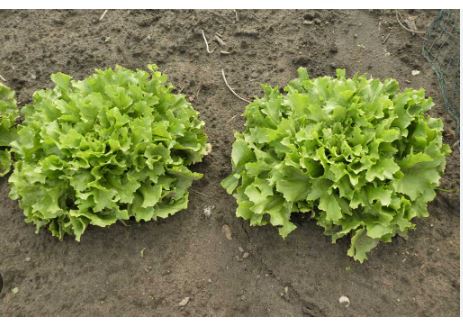
Endive (Cichorium endivia) is a leafy vegetable from the Asteraceae family, similar to chicory, with slightly bitter leaves. It is believed to have originated in Egypt and Indonesia and cultivated in Europe since the 16th century.
Endive comes in two main varieties: curly endive, also known as frisée, which has tightly curled, narrow leaves with a bushy appearance, and escarole, which features broader, flatter leaves with a less pronounced bitterness. Both types grow in a rosette with pale green to white inner leaves that are shielded from light, enhancing their tenderness and reducing bitterness.
Endive plants are biennials but are typically grown as annuals for their leaves. They prefer well-drained, fertile soil and can be sown directly into the garden or started indoors for transplanting. The plant thrives in cooler climates, with optimal growth temperatures ranging from 50 to 60 degrees Fahrenheit. To reduce bitterness, growers often blanch the leaves by covering the plant to block sunlight in the last few weeks before harvest. This process, known as forcing, can be done by tying the leaves together or covering the plant with an opaque material.
Nutritionally, endive is low in calories but high in fiber, which aids in digestion. It’s also rich in vitamins A, K, and C, and contains folate, calcium, and iron. The presence of inulin, a type of dietary fiber, not only supports digestive health but also might benefit blood sugar control by slowing down carbohydrate digestion.
In the kitchen, endive can be used in numerous ways. The outer leaves of curly endive are often used in salads where their bitterness contrasts well with sweeter or richer dressings or ingredients.
Curly Endive (Frisée)
- Characteristics: Known for its frizzy, curly leaves that range from yellow at the center to green at the tips. It has a slightly bitter flavor, which becomes more pronounced as the leaves get greener. Frisée is often used in salads for its texture and contrast in flavor.
- Origin: Cultivated forms of Cichorium endivia var. crispa. It’s believed to have originated in the Mediterranean region, with cultivation spreading across Europe by the 16th century.
Verde a Cuore Pieno
- Origin: Italy
- Characteristics: “Green with Full Heart” in Italian, this variety has large, dark green leaves with a light yellow center. It has a mild flavor and is often used in Mediterranean cuisine.
Escarole (Batavian Endive)
- Characteristics: Features broad, flat leaves that are less bitter than frisée. The inner leaves are creamy white, and the outer leaves are a darker green. Escarole is versatile, used in both salads and cooked dishes.
- Origin: Also from Cichorium endivia but the variety latifolia. Its cultivation has been widespread in Europe, particularly in France and Italy, for centuries.
Belgian Endive (Witloof Chicory)
- Characteristics: This is not true endive but a type of chicory (Cichorium intybus). It’s grown in the dark to keep it white and to reduce bitterness, resulting in a compact, cylindrical head with tightly packed pale yellow leaves.
- Origin: Originated in the 1800s in Belgium, where Jan Lammers discovered that chicory roots forced in the dark produced a sweeter, less bitter vegetable.
Radicchio
- Characteristics: Not technically an endive but often grouped with endives due to its similar use. It has a distinctive red and white color pattern, with a bitter flavor that can be mellowed by cooking or mixing with other greens.
- Origin: Another variety of Cichorium intybus, radicchio has been grown in Italy since ancient times, particularly in the Veneto region.
Puntarelle
- Characteristics: This is a variety of chicory where the shoots are eaten, traditionally prepared by soaking in ice water to curl them, reducing their bitterness. They have a unique crunchy texture.
- Origin: Mostly grown in Italy, especially around Rome, where puntarelle salad is a local specialty.
Sugarloaf Chicory
- Characteristics: Looks like a head of romaine lettuce but with a slightly bitter taste. It’s tender and can be eaten raw in salads or grilled.
- Origin: Developed from chicory, likely in Europe, used for its milder flavor compared to other chicories.
Catalogna Chicory
- Characteristics: This chicory has long, slender leaves with a dandelion-like appearance. It’s less bitter and can be eaten raw or cooked.
- Origin: Takes its name from southern Italy but is cultivated widely in Europe.
Treviso Radicchio
- Characteristics: A specific type of radicchio from Treviso in Italy, which has elongated heads with a crisp texture and a less bitter taste compared to other radicchios when blanched.
- Origin: Northern Italy, specifically Treviso, where it’s grown under strict guidelines to achieve its unique flavor and texture.
Salad King
- Origin: United States
- Characteristics: A very heat-tolerant variety with thick, curly leaves. Its durability makes it suitable for warmer climates. The leaves are mildly bitter, adding texture and a mild edge to salads.
Diva
- Origin: Europe
- Characteristics: Diva endive is recognized for its finely curled, lacy leaves. It has a mild bitterness and is prized for its decorative appearance, often used in upscale restaurant salads.
Cicoria Pan di Zucchero (Sugarloaf Chicory)
- Characteristics: Cylindrical heads with pale green leaves and a mild, sweet taste with minimal bitterness.
- Origin: Northern Italy.
- Use: Eaten raw in salads or used in sandwiches, but it can also be cooked to bring out a subtle sweetness. It pairs well with bold flavors like balsamic vinegar or blue cheese.
Scarola Bianca
- Characteristics: Light-colored, curly leaves with a less bitter taste than most endives.
- Origin: Italy, widely grown in Sicily.
- Use: Often eaten raw in salads, but it can also be lightly braised or grilled. Its mild flavor makes it adaptable for various dishes.
Red Endive (Cichorium intybus var. foliosum):
- Characteristics: Similar to Belgian endive but with red leaves, offering both visual appeal and nutritional benefits.
- Origin: Developed similarly to Belgian endive, with cultivation in various regions.